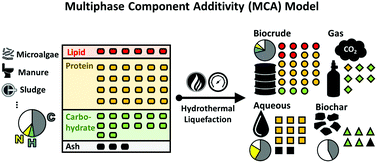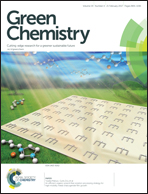Quantitative multiphase model for hydrothermal liquefaction of algal biomass†
Abstract
Optimized incorporation of hydrothermal liquefaction (HTL, reaction in water at elevated temperature and pressure) within an integrated biorefinery requires accurate models to predict the quantity and quality of all HTL products. Existing models primarily focus on biocrude product yields with limited consideration for biocrude quality and aqueous, gas, and biochar co-products, and have not been validated with an extensive collection of feedstocks. In this study, HTL experiments (300 °C, 30 min) were conducted using 24 different batches of microalgae feedstocks with distinctive feedstock properties, which resulted in a wide range of biocrude (21.3–54.3 dry weight basis, dw%), aqueous (4.6–31.2 dw%), gas (7.1–35.6 dw%), and biochar (1.3–35.0 dw%) yields. Based on these results, a multiphase component additivity (MCA) model was introduced to predict yields and characteristics of the HTL biocrude product and aqueous, gas, and biochar co-products, with only feedstock biochemical (lipid, protein, carbohydrate, and ash) and elemental (C/H/N) composition as model inputs. Biochemical components were determined to distribute across biocrude product/HTL co-products as follows: lipids to biocrude; proteins to biocrude > aqueous > gas; carbohydrates to gas ≈ biochar > biocrude; and ash to aqueous > biochar. Modeled quality indicators included biocrude C/H/N contents, higher heating value (HHV), and energy recovery (ER); aqueous total organic carbon (TOC) and total nitrogen (TN) contents; and biochar carbon content. The model was validated with HTL data from the literature, the potential to expand the application of this modeling framework to include waste biosolids (e.g., wastewater sludge, manure) was explored, and future research needs for industrial application were identified. Ultimately, the MCA model represents a critical step towards the integration of cultivation models with downstream HTL and biorefinery operations to enable system-level optimization, valorization of co-product streams (e.g., through catalytic hydrothermal gasification and nutrient recovery), and the navigation of tradeoffs across the value chain.



 Please wait while we load your content...
Please wait while we load your content...